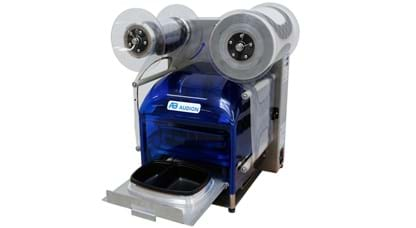
MSS tray sealer
Manual tray sealer
- MAP: No
- Type of machine: Manual
- Capacity: Small / Medium
- Type of package: Tray, cup etc.
Choose a country to view content specific to your geographical location
Everything you need to know to choose the right tray sealing system for your business.
Whether you are a supermarket butchery packing and sealing hundreds of food trays per day, or a growing food manufacturer just exploring tray sealing for your products, getting the right tray sealing solution for your business is crucial.
But where do you start? Read on for everything you need to know to choose the right tray sealing system for your business.
Get the correct product presentation that suits the desired image of your company so your product stands out of the competition.
There are many benefits to tray sealing products, but these are the biggest drawcards:
What is the tray sealing process?
Regardless of the size of your operation, the tray sealing process has 3 fundamental steps.
Each of these steps relate to the three choices you’ll need to make when choosing your ideal solution.
1. Choosing your Food Trays
Choosing the types of tray to suit your product is the best place to start. Start by understanding which materials suit your type of product.
If your product is packaged fresh, snap-frozen or goes through major temperature changes in its final packaging, like being microwaved or oven-cooked from frozen, then a CPET food tray will suit you best. CPET stands for crystallizable polyethylene terephthalate – put simply, it’s a food grade plastic than can withstand extreme temperature changes, is made from up to 80% recycled material and can be recycled after use.
2. Choosing your Lidding Film
The next step is to visualize how you want your end product to look when it’s on the shelf. Do you need to weigh products and label them? Do you want your customer to see the food itself? Is brand consistency and recognition your driver? Answering these questions will help you choose the right lidding film
MSS small volumes
If you are just starting out, or only produce small quantities of food products, a well-built manual tray sealer like the Audion MSS would be the best choice. In general manual tray sealers rely on the operator to load the trays into the sealer, seal them and after that the excess lidding film must manually be removed. A big advantage of the MSS is it’s contour seal which results in an better presentation of your product.
AMAPS high volumes with MAP
If you are scaling up from small volumes, a semi-automatic tray sealer like the Audion AMAPS would be a good fit. Semi-automatic tray sealers take some of the legwork out of tray sealing. For example your staff might load food trays into the sealer and remove them manually, but the sealer will automatically apply the seal and spool any off-cuts of film.
Unique about the AMAPS is the patented gas flush system. This gives the AMAPS one of the highest output on the market. With this gas flush system also called MAP system you extend the shelf life of food products. The technology substitutes the atmospheric air inside a package with a protective gas mix. The gas in the package helps ensure that the product will stay fresh for as long as possible. The gas mix is depending on the type of product you would like to pack.
Ensuring the best possible flavour and cell structure of your meals which result in the better presentation of your product.
No vacuumpump but unique MAP technology which has a 3 times higher output. Not limited to the weak aspects of the vacuum pump.
Various sizes are possible; tray, cup, oval, triangle, menu tray etc.
Do you want to know what the Audion traysealers? Please feel free to contact me as I am looking forward to exploring together which packing solutions benefit you most

Evert Smink
International sales manager

Sales United Kingdom
Audion
Please fill in the below form and we will respond to you as soon as possible.